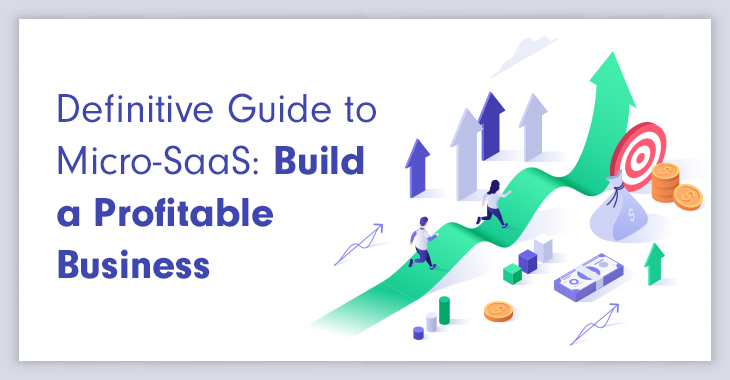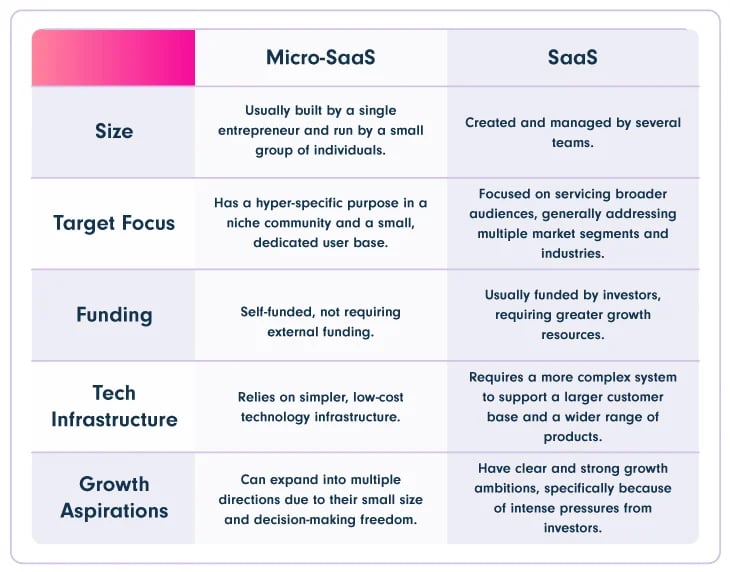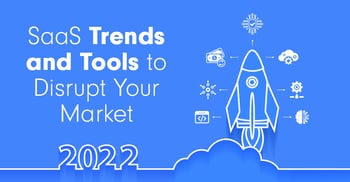Definitive Guide to Micro-SaaS: Build a Profitable Business

If you’ve been following the tech industry, you must have noticed the boom of the SaaS industry.
In a market worth $273.55 billion in 2023, opportunity is everywhere.
So, if the fire of entrepreneurship is burning inside you, this industry sector is for you.
While opportunity comes in many forms and shapes, one in particular seems to have grabbed everyone’s eye. The MicroSaaS gold rush is as real as it gets and understandable to give the rise of AI and low-code/no-code trends.
In this article, we’re going to take you on a MicroSaaS journey, helping you better grasp how to build, grow, and effectively sell SaaS online.
What is a Micro-SaaS?
Coined by Tyler Tringas, the Micro SaaS concept is an adaptation of the traditional software as a service model, operating on a much smaller scale, having a narrow focus and a dedicated user base. (This is why it’s also called ‘Small SaaS’).
Part of a growing market, MicroSaaS solutions developed around one of the popular passive income ideas for software developers can generate revenue with minimal resources and are widely perceived as a low-risk product.

Micro-SaaS Vs. SaaS: 5 Top Differences

3 Micro-SaaS Ideas For 2024
Before we get into the nitty-gritty of Micro SaaS, let’s have a quick look at three 2024 trends worth considering. Whether you incorporate them into your apps or use these Micro-SaaS ideas as fuel for thought, it’s always good to know where the industry is heading.
1. Artificial Intelligence
Artificial Intelligence is a massive thing in the technology market, worth no less than $120 billion. Wherever you look, whatever you do, there seems to be no escaping it.
With 35% of companies using AI in their daily operations, it is no surprise that almost all of the business ideas these days are connected to this sector.
Whether you are integrating it as a core feature of your Micro-SaaS software, like an AI-powered customer segmentation tool, or employing different machine learning algorithms to automate processes and streamline app development, the point is to harness its power.
2. No-Code / Low Code
When looking to build a Mico-SaaS, you need to be very mindful of the costs involved. Remember that one of the essential differences between a Micro-SaaS product and a traditional software as a service is the use of minimal development resources.
With so many available no-code/low-code platforms, software development is no longer reserved for experts. You can now build a powerful Micro-SaaS solution using no code systems without breaking a sweat.
Basically, you can focus on polishing your idea, adding functionality, and creating a growth plan while leaving the coding to platforms like
Bubble, Webflow, or Airtable.
3. Vertical Micro SaaS
Popular in 2023 and definitely in the books for 2024, Vertical SaaS is very much oriented toward niche communities, looking at unique challenges.
Now, if you were to verticalize your Micro-SaaS model, what you would get is a product that resonates with your target audience, offering highly specific features.
There are a lot of Micro-SaaS ideas that make all the sense in the world but this one in particular. It gives you the tools to stand out among generalized software and capture more leads.
4 Reasons Why Micro-SaaS Works
There is a lot of hype around Micro-SaaS products, and we can tell you why. Here are a few reasons why the Micro-SaaS concept is so popular among developers.
Greater Revenue
The Micro SaaS business model has the potential to generate more revenue than traditional SaaS platforms because they require fewer resources to develop and maintain. Plus, the subscription business model fits these platforms like a charm, allowing developers to create recurring revenue streams.
Lower Start-up Costs
Micro-SaaS, as opposed to traditional SaaS startups, requires lower investments to develop and maintain. This also means business owners can roll out more products in a shorter time frame.
More Innovation and Flexibility
Because Micro-SaaS is not externally funded, they are more agile and flexible. Owners are free to make their own business calls, being able to rapidly respond to market changes. Plus, the fact that they are not bound to legacy systems and processes makes it easier to roll out new apps.
Better Target Audience Positioning
Micro-SaaS targets niche communities, and by providing hyper-specific features, this platform type empowers users and usually has a real impact within the SaaS landscape. Additionally, because of their small size, they can achieve seamless communication and customer assistance, which translates into a loyal customer base.
The 3 Essential Steps in Building a Micro-SaaS
Step 1: The Idea
The most important aspect of building successful Micro-SaaS solutions is the idea. Without a good idea, your product could easily get lost in the competitive SaaS industry.
So, how do you go about this first challenge? We have a few thoughts on this.
You must be 100% certain that you are bringing something new to the micro SaaS table.
Keeping an eye on industry trends is definitely something you need to do. Why?
They will help you connect to your customer base on a practical level, give you some interesting micro SaaS ideas, and encourage relationship building, a goal in all your marketing efforts.
Once you have an idea, you need to validate it:
Do your research and identify your competition. Use Tools like ProductHunt or RequestForProduct to identify ideas.
Think about how you can beat similar products by offering extra features or improved processes.
Get feedback from targeted customers using social media platforms, forums, or other user groups to better understand their expectations.
Step 2: The Micro-SaaS MVP
Now that you have your idea, it’s time to start building.
Because the technology market operates with lightning speed, you must move fast and piece together your minimum viable product. So, what’s the first thing you need to do?
Decide on features. You need to look at core features that address the biggest pain points your target public has and nice-to-have capabilities that help enhance the overall product experience.
To do this, you need to make up your mind on whether you want to:
Assist existing solutions: These Micro-SaaS ideas provide additional functionalities that make the available product more powerful or versatile.
Build an independent Micro-SaaS product: These products are autonomous and come to fix a specific issue ( browser extensions or add-ons are great examples in this respect).
Once you decide what you want, you can bring your Micro-SaaS idea to life. Using a no-code platform will allow you to build your MVP fast and without requiring huge investments, which is exactly what you want.
To build a micro SaaS, you should consider tools like:
Bubble: A no-code development platform that can be used to build web apps. With its drag-and-drop interface and plenty of pre-built components, Bubble makes web building easy.
Make: a no-code tool that automates takes and workflows. It can connect with over 1,000 different apps.
AppSheet: A drag-and-drop, no-code platform suitable for building mobile applications.
Step 3: The Sales
Just like with any other product, once you have MVP ready for launch, you need to figure out a way to effectively identify revenue streams and optimize them.
Here are a few ways to do this.
Identify your target users: With the right audience targeting Micro SaaS has a strong niche domination potential. Take the time to properly identify a group your Micro SaaS products appeal to, understand their pain points, and present your solution as the perfect fit to establish brand loyalty.
Set the right pricing strategy: Depending on your product, you can choose from a multitude of pricing models and techniques. Pricing tiers are a good idea for all SaaS products, as well as free trials or the freemium model. The idea is to experiment with as many models as possible and continually optimize your strategy to align customer demands with profit goals.
Play with upselling, add-ons, or cross-selling: Increase the number of your revenue streams by identifying growth opportunities from your existing customer base. Entice them with access to premium features to upgrade to more expensive plans or recommend complementary products that would improve their experience.
Focus on retention strategies: A profitable Micro SaaS business is one that not just gains customers but keeps them for as long as possible. For your customers to stay by your side, they need to be satisfied with your product. So, solve as many customer support tasks as possible, and provide personalized training and assistance.
Evaluate your efforts: It’s imperative that you constantly improve your processes by collecting valuable insights from multiple channels. Check your social media engagement, review customer satisfaction through surveys, and consider market trends or industry best practices.
5 Steps To Developing a Strong Marketing Approach
SaaS marketing is much more strategic than traditional marketing because it focuses on building long-term relationships.
Instead of solely focusing on making the purchase, SaaS developers need to ensure that they create solid SaaS retention channels.
Retention creates steady revenue sources, providing devs with sufficient capital to continue improving products and developing new ones. That is the end goal.
Plan How You Will Obtain Your First Paying Customers
One benefit of developing a Micro-SaaS in an industry you are already familiar with is that you will know where to find its most likely customer base. Suppose you are developing services for an unfamiliar industry.
In that case, it will benefit you to search on forums and across social media for dedicated groups (such as Subreddits and Facebook groups) and people seeking a solution like yours to gain a complete understanding.
Once you’ve found your potential customer base, devise a basic but targeted marketing strategy to draw in those first customers. Remember that you can do this with beta testing or even an early access release, which will allow customers to use your software at discounted prices in exchange for feedback on usability.
Set your Marketing Objectives and Goal
If SaaS were a person, it would have been a data enthusiast. But before you can start using SaaS metric benchmarks to measure your progress, you need to know what you are tracking in the first place. SMART KPIs and OKRs are specific methodologies that SaaS developers love using.
When establishing your SMART goals, keep in mind that these are:
Specific
Measurable
Achievable
Realistic
Time-bound
The OKR methodology is goal-oriented. It allows companies to outline their key objectives and set realistic targets. It also allows for greater company transparency, allowing for better internal communication and big-picture understanding.
OKR’s are being used in more companies after large tech businesses like Google popularized them. Whichever option you choose, make sure you set achievable goals and objectives before anything else.
Consider Inbound Marketing
Once you’ve identified your customer personas, it’s time to get started with their pain points. This might sound heartless, but it's meant to be helpful. You need to leverage those pain points and establish your product as a top solution.
Position yourself as an industry expert by using inbound marketing to your advantage and providing your audience with consistent information. Your potential users need to know what your SaaS can do, and you can only achieve that by aggressively educating them.
Determine Your Contact Methods
You must take the time to optimize your customer engagement with user-activated communication (such as email reminders about abandoned shopping carts). If you simply send them frequent email advertisements, you risk annoying your customers and being dismissed to the dreaded Spam folder.
Remember, your customer isn’t interested in your product for its own sake; your customer wants to know how your services will benefit them.
Create a Competitive Pricing Plan
Before deciding on prices, the first thing to do is research industry standards. You will need to balance affordability with profitability while creating optimal product packages that give your business the margin it needs to survive.
Because Micro-SaaS companies don’t offer a variety of solutions, it wouldn’t make sense to diversify your product packages too much. Instead, consider offering free trials for limited periods or SaaS pricing allowing the unrestricted use of limited features. Be cautious, however, about setting your prices too high or too low.
Overcharging will alienate your customers, whereas setting your prices much lower than competitors may lead to customers questioning the quality of your services.
And finally, remember that quality is valued more than quantity. Overloading your target customer with too many options is more likely to overwhelm them than convey a sense of flexibility. A pricing plan that offers two to three options is optimal for Micro-SaaS.
10 Micro-SaaS Products Worth Mentioning
Carrd
Starting out as a small scale SaaS business with no intention of turning into a tech unicorn, Carrd is a real-life success story.
Today, this tool is one of the most popular one-page website builders, packed with numerous great features like Google Analytics, forms, and widgets, with over 2 million users and $1 million in ARR. The numbers are impressive, but how the founder reached them makes an even better story.
A beautiful combination of the free plan strategy, social movement, and accidental influencer marketing has led to Carrd’s current success. It’s like a puzzle that effortlessly comes together.
Why It’s Relevant?
Carrd is the definition of the Micro-SaaS process. It’s simple to use, highly responsive, does a great job of empowering users, leaving them with a real sense of satisfaction, and is free to use. Yes, you can upgrade, but you can test the product first and decide if it’s for you.
Lionize
Lionize is an influencer marketing platform that allows brands to quickly identify the right influencer candidate for different brands.
Because this Micro-SaaS idea has gained quite a success since its launch, you would assume it has to do with its niche social media performance.
The truth is that it’s more than that.
Why It’s Relevant?
By tapping into one of the essential tools in online marketing and making it easy for founders to integrate influencers into their social media strategy, Lionize sets the stage for becoming a viral product.
Additionally, by employing AI, one of the hottest trends in the market, and its proprietary engine, this platform delivers impressive results in connecting the right influencers with brands. Users obtain real value from using this platform quantifiable in their sales or sign-ups.
Swapstack
Swapstack is a newsletter ads marketplace where newsletter authors and advertisers meet and accomplish their goals.
Through this service, authors can monetize their ideas, and advertisers can scale their marketing efforts.
Why It’s Relevant?
Because newsletter marketing is part of a larger marketing plan, it makes for a strong micro SaaS idea. Both the service provider (newsletter author) and the advertisers find benefits in what Swapstack has to offer. In other words, this platform offers parallel conversion, which is regarded as highly advantageous.
Anytrack
Anytrack is a Micro-SaaS app that allows businesses to track conversions in all marketing channels. By having everything in one platform, users can have a better view of which channel brings the best results.
Moreover, based on the insights gained, business owners can make better decisions, capable of bringing increased conversions.
Why It’s Relevant?
Anytrack is a fine example of Micro-SaaS for two reasons. First, it has effectively identified an issue and brought forward a strong solution. Secondly, it offers free-trial options, allowing interested customers to test it.
Plutio
Created in 2017, Plutio is a task management app that allows freelancers and small SaaS businesses to oversee every aspect of their business.
Through different helpful features like time tracking, real-time task creation, messaging, and progress sharing, Plutio has gained a high level of popularity.
Why It’s Relevant?
What makes this app interesting is its increased flexibility. Functioning on the free trial model, a prolonged free trial, the user has sufficient to convince themselves whether the product is a good fit.
Zendesk
One of the most popular customer support software platforms, Zendesk is highly appreciated by both growth SaaS startups to large enterprise companies.
Using this platform brings several advantages, such as reduced customer support costs, improved customer satisfaction and brand reputation, and even boosted user loyalty.
Why It’s Relevant?
Speaking of Micro-SaaS fame, Zendesk fits the part like a charm. There are three reasons why this company deserves to be on this list.
One, it’s incredibly easy to use, being a solid choice for businesses with no tech expertise.
Two, it’s highly affordable, including for small businesses.
Three, it’s scalable and can be used by companies in different growth stages.
Commando
Commando is a cloud-based server management platform that allows startups and small-sized businesses to gain control over their servers without being forced to hire dedicated experts.
Through different features like powerful integrations or quick code deployment, this Micro-SaaS solution solves a rather pressing issue for businesses with limited operational resources.
Why It’s Relevant?
Similar to some of the best Micro SaaS ideas, this platform solves a specific problem and does so effectively. It is also easy to use and scalable, being thus able to boost its audience.
Hypefury
Do you know that because of the popularity and growth power social media marketing offers, some of the best Micros SaaS ideas revolve around this topic?
Hypefury, the virtual personal assistant that helps users monetize their Twitter accounts, comes to exactly that. This service allows you to increase your engagement by auto-tweeting your most popular tweets or turning your blog posts into threads.
Why It’s Relevant?
This service provider has reached impressive success because it decided to avoid spending money unnecessarily. Operating at a small scale, having their teams made up of only a few members, and focusing only on primary resources that would allow them to function gave Hyperfurry time to prepare for growth.
Additionally, the app uses the freemium model, having, of course, paid plans as well.
ProveSource
Founded in 2018, ProveSource is all about social proof, helping customers increase their credibility.
The app offers an interesting perspective on displaying website data. Instead of keeping it all to yourself, ProveSource lets shoppers click on recent order pop-ups to see products recently bought by other customers. This shows that your business is trustworthy and credible, which can boost sales over time.
Why It’s Relevant?
What makes this micro-SaaS product interesting and worth being part of this list is the way ProveSource validated the idea.
Before creating the product, a landing page was created, and users were asked to sign up to receive updates about the proposed solution. The more users signed up, the greater the interest in the product would be, motivating its exitance.
Storemapper
Founded by Tyler Tringas, the Micro-SaaS pioneer, in 2012, Storemapper is now one of the most popular store locator map development platforms. Just by considering the type of product Storemapper is, you can easily tell that it’s very Micro-SaaS.
This is a plug-and-play type of solution that allows users to create and manage store locations on a map.
Why It’s Relevant?
This is one of those essential Micro-SaaS tools that does everything by the book. It solves a specific problem in the best possible way, it is simple to use and has free and paid plans, which introduce the user to premium features like map customizations or bulk uploading.
Why waste time, money, and effort with in-house solutions when you can keep up with the latest SaaS growth innovation at a fraction of the cost.
Sell your SaaS globally with PayPro Global!
How can PayPro Global Help?
PayPro Global’s robust subscription management system allows all SaaS & software developers to effortlessly sell their products while securing steady revenue streams and eliminating the SaaS risk.
By providing users with access to innovative reporting tools, you can segment and target your audiences worldwide, letting you adapt sales strategies. This way, you are bound to notice a significant conversion boost.
Additionally, PayPro Global equips your business with multiple sales models, anything from trials, usage-based billing, and freemiums to demos, giving you the opportunity to profile your niche audience and select the best-performing pricing strategy.
Because you are awarded multiple billing cycle customization options and manual and automatic renewal mechanisms, you can attract new customers constantly.
In terms of nurturing, the upsell strategies we offer our users can easily upgrade existing customers to superior subscription plans, adding to the existing revenue.
Final Thoughts
A micro-SaaS provides an excellent way to solve a problem in micro-SaaS niches while building a loyal customer base.
Furthermore, unlike horizontal SaaS, because of its low financial and resource demands, you don’t have to spend time and energy putting a team together or finding sponsors.
Remember that a Micro-SaaS comes with unique challenges that more conventional SaaS models do not face.
If you’re looking for a full-service e-commerce partner to help you sell software online and kick-start your Micro-SaaS business, get in touch with us at PayPro Global.
We’ve been in the business of helping people grow their businesses for many years, and our experienced team is available to help no matter where you are located. We would love to hear about your goals and help you achieve them!
FAQ
What is a micro SaaS?
A micro SaaS is a cloud-based software application that typically provides a single, specialized solution to customers. Micro SaaSes are usually delivered through a reseller or an online marketplace, and their development tends to be focused on one primary area or business function. The term “micro SaaS” is cousin to the term “microservice,” which describes a specialist software service that forms part of a larger application.
How can I make SaaS profitable?
Firstly, your pricing needs to be spot on. You need to find the perfect balance of offering enough value to justify your price point, while simultaneously not pricing yourself out of the market.
Secondly, you need to have a solid customer acquisition strategy. You need to focus on acquiring high-quality customers who are likely to stick around and become loyal users of your software.
Lastly, you need to have a rock-solid retention strategy.
What is a good margin for SaaS?
A good margin for SaaS is anything over 72%. That's because, once you've paid for the cost of your software and infrastructure, the majority of your revenue should go towards covering your costs of customer acquisition and servicing. Anything above that margin will help to grow your business and increase profitability.
Ioana Grigorescu
Ioana Grigorescu is PayPro Global's Content Manager, focused on creating strategic writing pieces for SaaS, B2B, and technology companies. With a background that combines Languages and Translation Studies with Political Sciences, she's skilled in analyzing, creating, and communicating impactful content. She excels at developing content strategies, producing diverse marketing materials, and ensuring content effectiveness. Beyond her work, she enjoys exploring design with Figma.
-
1.Explore PayPro Global's Solutions: See how our platform can help you streamline your payment processing and boost revenue.
-
2.Get a Free Consultation: Discuss your specific needs with our experts and discover how we can tailor a solution for you.
-
3.Download our Free Resources: Access valuable guides, checklists, and templates to optimize your online sales.
-
4.Become a Partner: Expand your business by offering PayPro Global's solutions to your clients.
Get the latest news



